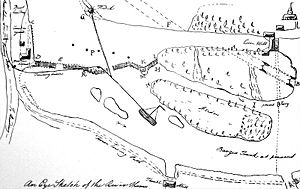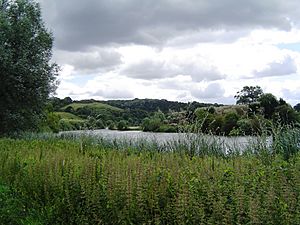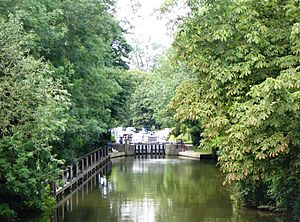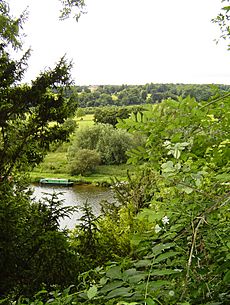Whitchurch Lock facts for kids
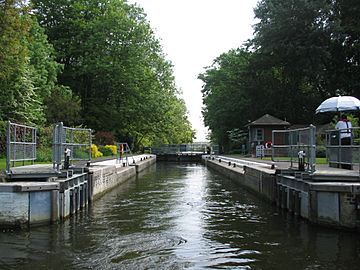
Whitchurch Lock with head gates open
|
|
| Waterway | River Thames |
|---|---|
| County | Oxfordshire |
| Maintained by | Environment Agency |
| Operation | Hydraulic |
| First built | 1787 |
| Latest built | 1876 |
| Length | 41.22 m (135 ft 3 in) |
| Width | 5.48 m (18 ft 0 in) |
| Fall | 1.01 m (3 ft 4 in) |
| Above sea level | 130' |
| Distance to Teddington Lock |
61 miles |
Whitchurch Lock is a special kind of gate system, called a lock, and a weir (a small dam) on the River Thames in England. It's a type of lock known as a pound lock. This lock was built by the Thames Navigation Commissioners way back in 1787. You'll find it on an island near the village of Whitchurch-on-Thames in Oxfordshire. The only way to get to it is by boat!
The weir, which is like a low wall across the river, stretches from the island to the village of Pangbourne in Berkshire.
Contents
History of Whitchurch Lock
Long before the current lock, there was a simpler type of lock here called a flash lock. Records show it existed in the 1500s. A flash lock worked by holding back water with a dam. When boats needed to pass, part of the dam would be opened. This created a rush of water that helped pull boats through. It was a bit like a mini-flood to move boats!
The sketch shows how the old flash lock looked. It had a main dam that was quite solid. Near the south bank, there was a special gate called a sluice. This sluice was about 30 feet (9.1 m) wide. It had flood gates and boards that could be opened to let water through. The flash lock itself was in the middle, about 23 feet (7.0 m) wide. There was a winch on the north bank to help pull barges (flat-bottomed boats) against the strong current.
- Flash Lock: An early type of lock that used a sudden rush of water to move boats.
- Pound Lock: A more modern lock with two gates that fill or empty a chamber to raise or lower boats.
Building the Pound Lock
The modern pound lock, made of strong oak wood, was built on the island in the summer of 1787. Before building, people thought about two other places for the lock. One idea was to make the mill stream on the Whitchurch side wider. Another was to dig a new channel across land near the Swan public house in Pangbourne.
In the 1830s, a house for the lock keeper was built on the island. Later, in the late 1800s, some local people used to walk across the weir to avoid paying tolls on the nearby bridge. Because of this, the lock was rebuilt in 1876, and access across the weir was closed off. The path from Whitchurch to the lock was also closed in 1888.
Getting to Whitchurch Lock
Whitchurch Lock is unique! It's the only lock on the entire River Thames that you can't reach by walking or driving. The only way to visit it is by boat.
The River Above the Lock
The part of the river just above Whitchurch Lock is very scenic. It flows along the Chiltern Hills and ends at a narrow valley called Goring Gap. About halfway along this stretch, you'll see the Gatehampton Railway Bridge.
On the Oxfordshire side, the hills are home to houses in Whitchurch. Further along, you'll see the beautiful Hartslock beech woods. This name comes from an old lock that used to be among the islands below the hills. Even though that old lock wasn't used anymore when the pound locks were built, parts of it remained until 1910. The river then turns west, leaving flat meadows all the way up to Goring.
On the Berkshire side, the river passes by Pangbourne. Here, you can spot seven unique Edwardian-style houses right by the river. Beyond this point is Beale Park, a fun place to visit. A bit further from the river is Basildon Park, a grand country house. The river then turns north again at the Goring Gap, where the hills near Streatley rise high above the water. Just before Goring Lock, you'll find Goring and Streatley Bridge.
Pangbourne College is located along this part of the river. The Pangbourne Junior Sculls, a rowing competition for young people, takes place here in November.
The Thames Path, a walking trail, crosses Whitchurch Bridge. It then goes away from the river through the streets of Whitchurch and into the woods. This part of the path has some steep climbs and many steps. Once it returns to the riverside at Hartslock, it continues along the Oxfordshire bank all the way to Goring.


